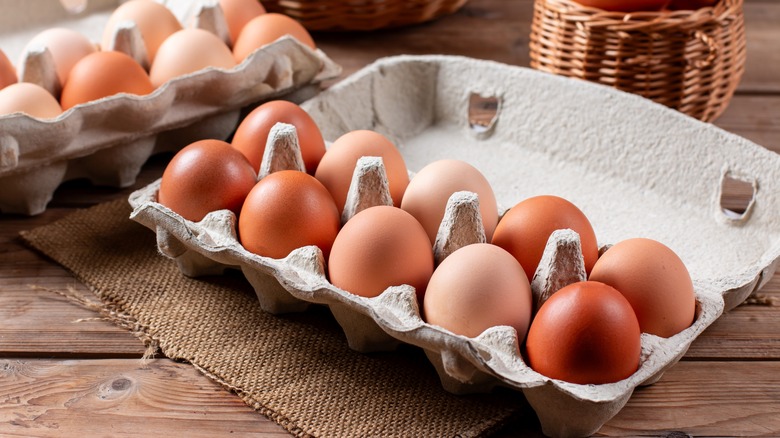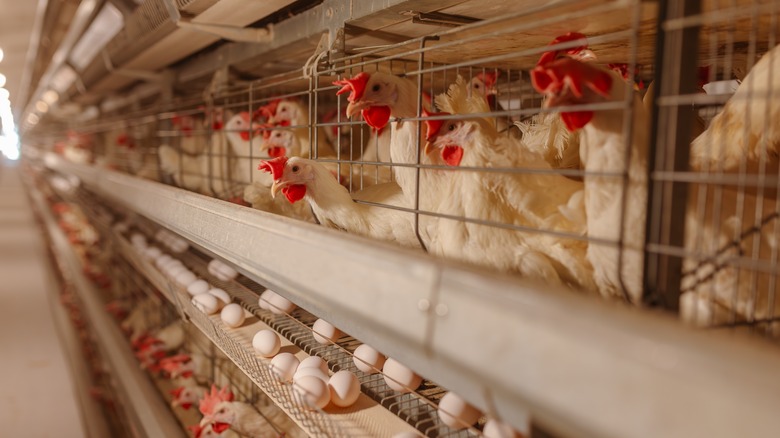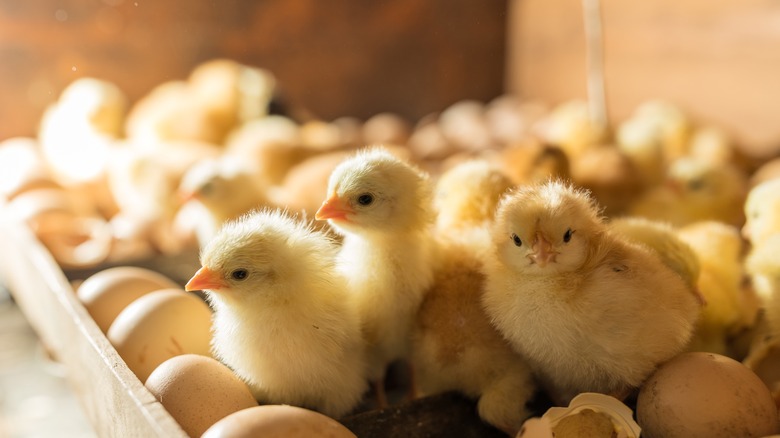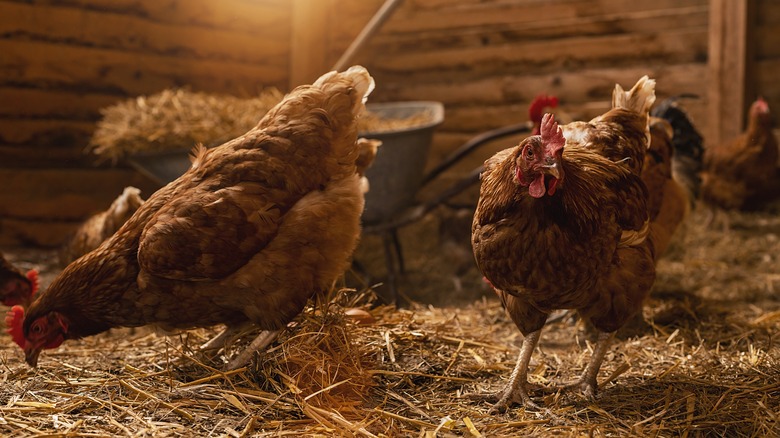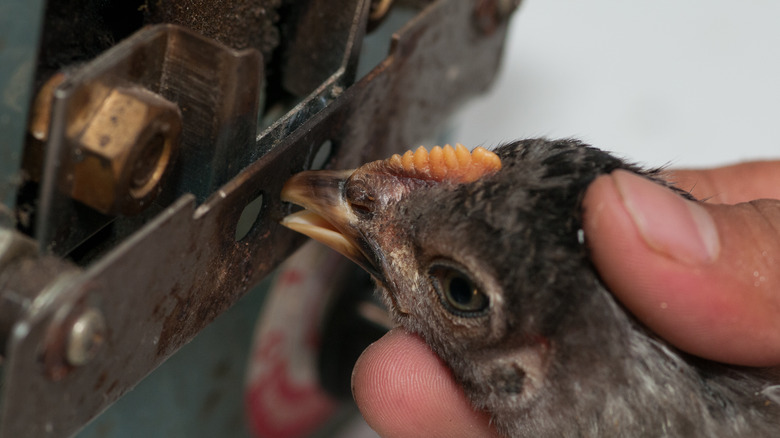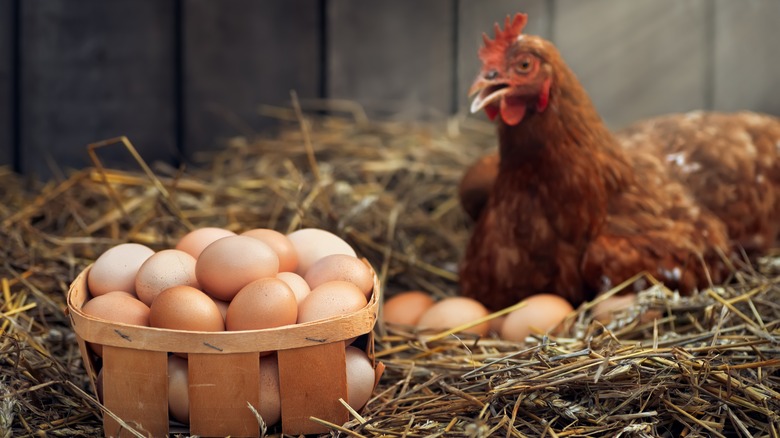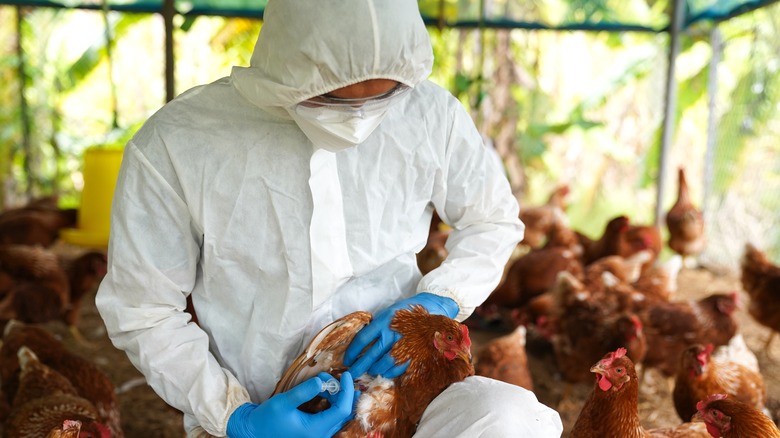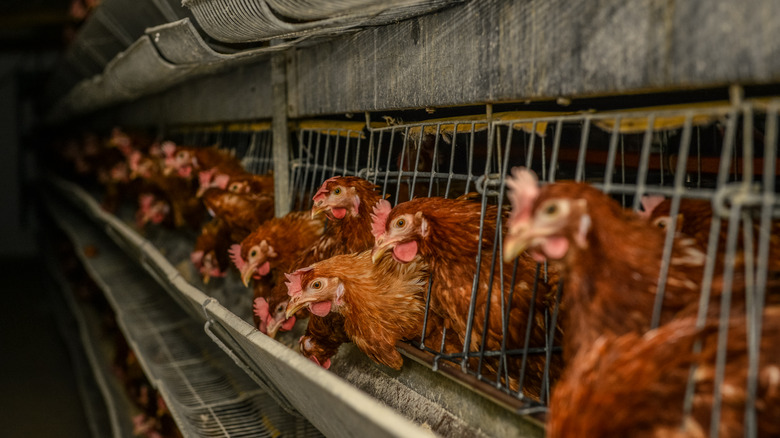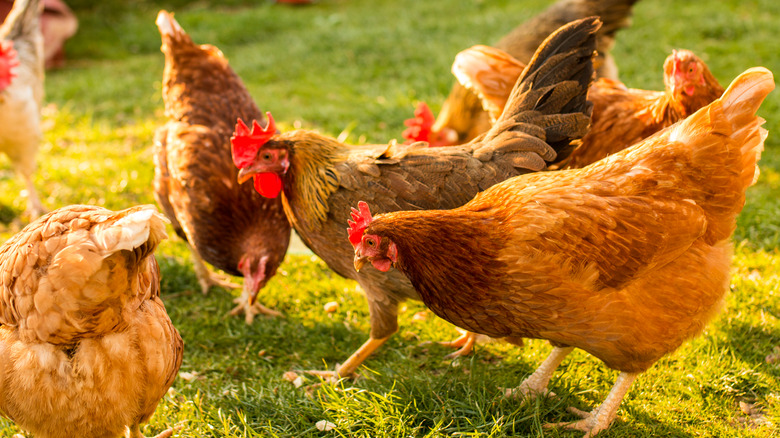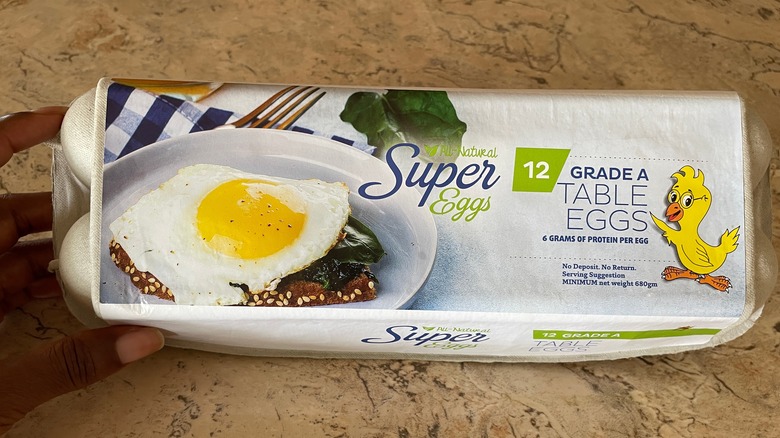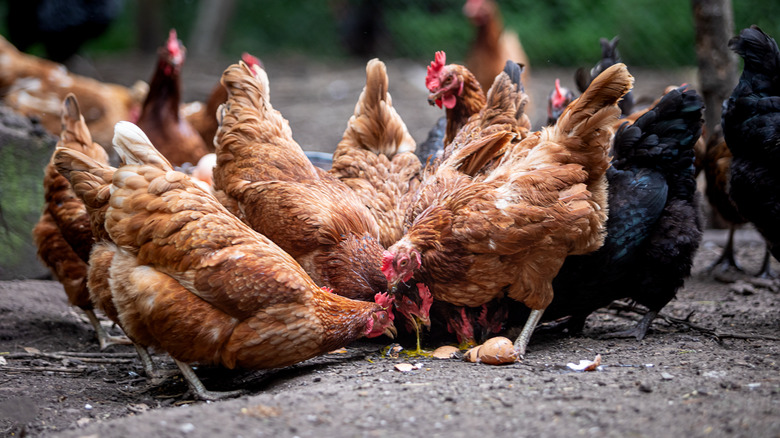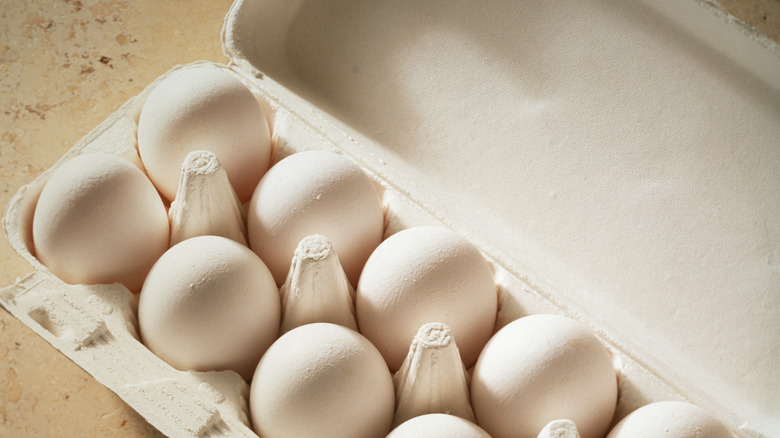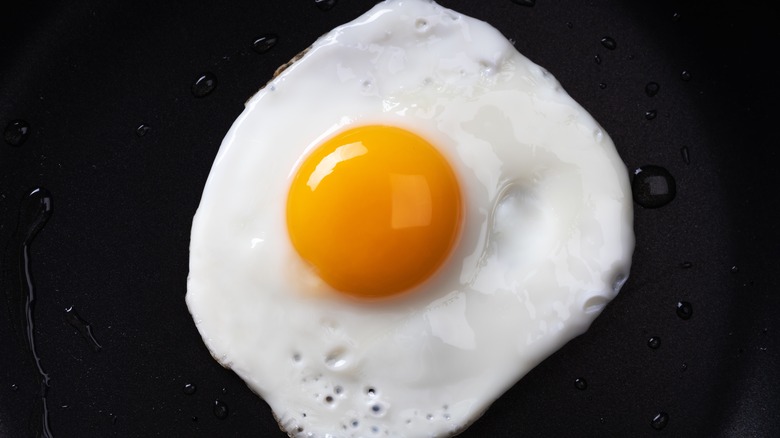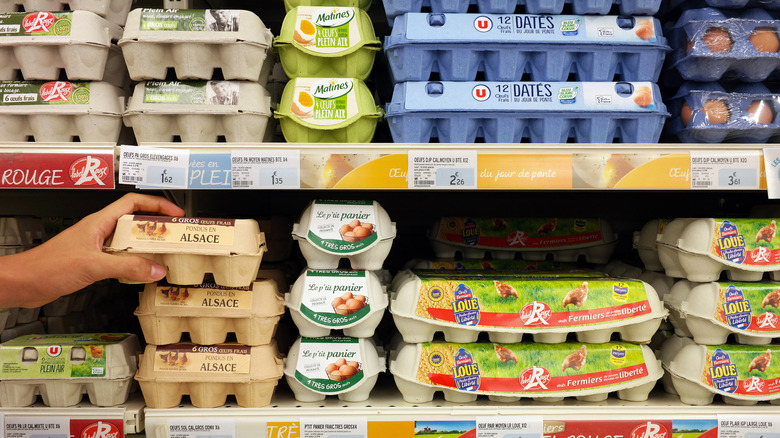Insiders Expose Secrets Of The Egg Industry
The egg industry can be a confusing place, with a host of labels touting a variety of humane practices and health benefits, many of which don't mean anything at all. Given the ever-skyrocketing prices for even bog standard eggs, now more than ever, it's essential for consumers to inform themselves about what's really going on behind the scenes.
The conventional egg industry in the U.S. is riddled with unsavory secrets, with most egg-laying hens living in inhumane conditions that contribute not just to their suffering, but to lowered nutrition in the resulting eggs, as one 2010 study from Penn State University found. It's for these reasons that Mark Kastel, founder of OrganicEye, recommends sourcing eggs from small family farms whenever possible. "The eggs will be more nutrient-dense, the birds will live a 'happy chicken-life,' your dollars will stay in the local economy, and you will be promoting economic justice for the people who produce your food."
That said, if this isn't an option, you'll need to navigate the industrial egg waters, and thankfully, our experts are here to help. Get ready to have your eyes opened to the realities of the egg industry — and your power as a consumer to choose the best options for you.
Most eggs come from horrendous facilities
In the U.S., most egg-laying hens do not lead the pastoral lives on-package marketing may lead you to believe they do. According to the USDA, as of 2024, about 60% of American egg-laying hens spend their lives living in wire cages, with less living space per hen than the size of a piece of paper. These cramped conditions mean it's impossible for hens to perform normal animal behaviors, like wing flapping and feather ruffling.
"Almost all conventional eggs are produced by hens that are confined to giant buildings for their entire lives," says Mark Kastel. "Many are crammed into cages where they can't even turn around and, because of the stress, are subject to physical abuse from their flat mates (hence the term 'pecking order')."
Moreover, hens spend the majority of their short lives in pain. Bone fracture is common, according to a study in the Journal of Animal Sciences, leading to acute and chronic pain for the hens. Caged hens, on average, endure significantly more pain over the course of their lifetimes than if they were in cage-free environments.
Male chicks born in egg-laying facilities are put to gruesome death
It should be unsurprising to anyone familiar with basic biology that male chicks are useless in the endeavor of egg-laying. What might be surprising is that these chicks cannot be raised instead for meat. "The era of dual-purpose breeds, producing meat birds and laying hens, ended decades ago," explains Mark Kastel.
As a result, male chicks are typically culled and killed through a series of means, each more medieval than the last. According to the nonprofit Animal Equality, male chicks are most commonly suffocated, though they may also be ground alive in industrial macerators, a method Kastel characterizes as "pretty grotesque." Some 300 million male chicks meet this fate each year in the United States alone, with more than 6 billion chicks dying this way around the world annually. The policy should certainly give some ovo vegetarians food for thought.
An egg-laying hen's life is short
Male chicks are not the only animals at egg-laying facilities whose lives meet a quick end. Indeed, perhaps the only silver lining gracing the lives of egg-laying hens who live in cramped, horrific conditions is that their lives aren't terribly long. According to Mark Kastel, most hens mature to about 16 weeks before moving to the laying house, where they'll remain for about a year. But as they age, hens produce fewer and fewer eggs, making them less profitable for the industry. While laying hens' natural lifespan is about five years or more, after just over two years, declining egg output leads most laying hens in the U.S. to be slaughtered.
Because egg-laying hens are not bred to grow big and fat the way meat chickens are, they are not typically marketed for human consumption. Instead, they are usually transformed into pet food and livestock feed — when they aren't simply disposed of like male chicks.
Hens react to their conditions with mutilation and death
It's difficult to accurately quantify animal pain, but evidence of the distress experienced by egg-laying hens in industrial facilities is undeniable. Living in cramped conditions, often in wire cages that hurt their feet, causes hens not just pain but stress, which often leads them to self-mutilate or even cannibalize other hens.
Rather than modify the living conditions of the hens, to reduce the violence many industrial egg producers simply remove a portion of the hen's beak with infrared energy or a heated blade, making it impossible for them to peck. The process is typically performed without pain relief and can affect the bird's ability to exercise natural animal behaviors, such as foraging for food. Hens can also develop neuromas following this process, a chronically painful regrowing of nerve fibers in the beak. When debeaking is necessary, infrared energy is considered the more humane option of the two.
Hens are starved to produce more eggs
Forced molting is a process whereby farms starve hens for a matter of weeks before feeding them again as usual. "Forced molting means unnaturally altering the hens' environment and diet for a period, which 'turns off' their internal egg-laying mechanisms, and subsequently manipulating their natural processes to then return them to egg production," explains Tom Flocco, CEO of Pete & Gerry's, LLC. According to Mark Kastel, "In conventional operations, the practice is used to raise production and extend the productive lifespan of the birds."
Illegal in Europe and banned in organic production, this is nevertheless "a commonplace practice in caged and cage-free production," according to Flocco. As of 2006, United Egg Producers began recommending a non-feed withdrawal molting method developed in university research. This practice relies on feeding hens a lower-protein and lower-energy diet, and is followed by most of the commercial egg industry.
Pete & Gerry's and Nellie's eggs are raised to Certified Humane Free Range and Pasture Raised standards, both of which prohibit forced molting, Flocco explains. This, he adds, is "consistent with our brand's core values of raising hens according to the most natural lifestyle for the birds and to the highest standards of humane animal welfare."
Avian flu leads to mass slaughter, egg shortages, and price gouging
Hens' lives can be cut even shorter due to outbreaks of diseases like avian flu. But chickens aren't always dying of the virus. Instead, processing facilities often sacrifice their entire flock when the virus is confirmed on-site, as was the case in Sonoma County in early 2024 when egg producer Mike Weber was forced to slaughter all of his 550,000 hens to prevent the virus from spreading, or in Minnesota, where nearly 1 million chickens had to be sacrificed for the same reasons.
While it's understandable that the industry would need to take action to reduce the spread of the virus, this policy is devastating for egg producers — and makes eggs difficult to access for consumers. As a result of these practices, egg prices typically skyrocket due to shortages following avian flu outbreaks. In 2022, nearly 58 million chickens and turkeys were slaughtered to combat the virus, and the national average price for a dozen eggs reached $3.59 by November, up from $1.93 at the start of the year.
Egg production is a significant polluter
While it's far from being on the same level as beef or pork, egg production is a pretty big polluter, emitting around 4.8 pounds of carbon dioxide equivalent (CO2e) per dozen eggs, or around 1.16 pounds of CO2e per pound of eggs, as compared to 1.14 pounds for a pound of lentils. (By comparison, a pound of beef is responsible for about 15.5 pounds of CO2e, while chicken meat contributes about 1.8 pounds of CO2e per pound.)
Greenhouse gas emissions in egg production stem from a number of factors linked to the reliance on cereals and soy for feed. Producing these grains contributes to emissions from both nitrogen production and transport. It's no surprise, then, that pasture-raised hens contribute significantly lower emissions, according to Mark Kastel. "On truly sustainable [or] regenerative operations, birds are outside and rotated on pasture, with up to 15% of their feed coming from their foraging outdoors during the growing season," he says. "That's demonstrably less energy intensive than growing feed somewhere else and shipping it to the birds."
Humane labels are complicated and confusing
In an attempt to avoid purchasing eggs from farms engaging in inhumane practices, many customers look to the packaging. But navigating various label terms can be confusing and frustrating if you don't know your way around them.
Elisa Maloberti, Manager of Food Safety for American Egg Board, notes that the cage-free label implies that hens are raised in a barn without cages, equipped with scratch areas, perches, and nests. But Tom Flocco says this is "a common label that has been co-opted by factory farms," adding, "While cage-free standards may be better than the cages that still dominate the industry today, cage-free hens are still confined to larger cage-like structures in massive industrial facilities, rarely (if ever) given outdoor access."
Despite what the phrase may have you believe, free-range eggs are no better, coming from hens with a minimum of six hours of access to the outdoors per day — and according to Maloberti, "there's no regulation about how large an area it must be." Look for the Certified Humane® label, which requires birds have access to at least two square feet each, or Pasture Raised birds, which are allotted 108 square feet each. Maloberti adds, "Generally, the difference between free-range and pasture-raised eggs is that free-range chickens are raised in a barn with access to the outdoors, while pasture-raised hens are raised on an open pasture with access to shelter."
Other marketing terms have hollow meanings
Many on-packaging terms mean very little at all in the food industry. Take "natural," which is an unregulated term any producer is free to slap on its product, or "non-GMO" when applied to foods for which there are no marketed genetically modified versions, like oats. The egg industry is rife with such hollow terms.
"Hormone-free" is a lofty term that ultimately means very little, seeing as it's illegal to give hormones to egg-laying hens in the U.S. A similar problem plagues the "no-antibiotics" label, seeing as they are rarely used in the egg industry. Many labels are unclear about an essential element of the hen's life: its diet. "Chickens are not ruminants. They can't have an all-grass diet, regardless of what marketers try to represent," says Mark Kastel. "Even on the most competently managed pastured poultry operations, 85% of their diet will come from grains during the growing season and 100% during the winter."
Hens don't typically get to eat their natural diet
Another confusing label is the one touting that eggs are laid by vegetarian-fed hens. Chickens are naturally omnivores, seeking out insects and plant matter when left to their own devices. But most chickens in industrial egg-producing facilities are fed a grain-based diet — typically, according to Elisa Maloberti, made up of corn and soybean meal. This is despite the best diet, according to Mark Kastel, being "rotated pasture supplemented by certified organic grain."
Tom Flocco echoes this and says, "The best diet for an egg-laying hen is a combination of natural foraging and supplemental feed, which we are proud to provide to all our girls." He continues, "While free-range and pasture-raised hens can spend most of their days foraging for bugs and tasty greens, they are not ruminants, like cows, and therefore cannot get 100% of their dietary needs this way, and require a supplemental feed, as well. Laying hens rely on feed to round out their nutritional needs."
The dates on egg cartons are confusing
Depending on where you buy your eggs, you may see a number of different dates on the carton — and they don't all mean the same thing. According to Elisa Maloberti, the most common date you'll see on a carton is the Julian date, which corresponds to the day the eggs were washed, graded, and packaged. "As long as the eggs are kept properly refrigerated (at 45 F or lower)," she says, "fresh shell eggs are safe to be eaten four to five weeks beyond the carton's Julian date."
But some cartons provide more information, like an expiration or "sell by" date — and just because this date has passed, you don't necessarily need to toss them as it does not represent how long eggs really last. As Maloberti notes, while these eggs can no longer legally be sold, they are likely still good to eat. The final date you may see is a "best by" or "use by" date, which Maloberti says "indicates the date the eggs are at their peak quality. Depending on how much time has passed since the 'best by' date on the carton, the functionality of these eggs for baking, for example, may be less than optimal, but they may be perfectly fine to eat."
Some producers feed their chickens marigolds to fake a naturally golden yolk
Eggs with a bright yellow yolk have recently been rising in popularity due to the belief they reflect the nutrition of the egg. And to a certain extent, this is true. According to Elisa Maloberti, the brighter the yolk, the richer it is in carotenoids, which are naturally present in the corn and alfalfa meal in hens' diets.
"Our free-range and pasture-raised eggs tend to have much darker golden yolks than caged or cage-free eggs, primarily due to the carotenoids (yellow, orange, and red plant pigments) found in the clovers, grasses, and other greens that hens consume outdoors," echoes Tom Flocco. "We've found that most people agree that deeper orange yolks tend to taste creamier, richer, and more flavorful ... more like an EGG!"
But some producers looking to showcase this color without necessarily putting in the work that Pete & Gerry's do can resort to other means. "To enhance color in feeds made with wheat or barley that would produce lighter colored yolks, natural yellow-orange pigments from marigold petals or red pepper may sometimes be added," says Maloberti. Using marigolds to give egg yolks a color that doesn't reflect their actual health benefits could be constituted as an empty marketing promise, even if no artificial additives are used.
Only American eggs have to be refrigerated
Americans traveling abroad may be hard-pressed to locate eggs in the supermarket. In Europe, eggs aren't refrigerated, something Elisa Maloberti says is due to a U.S. government regulation that requires eggs to be washed and sanitized before going to market. This process removes the "bloom" from the outside of the egg, a protective coating she says seals the natural pores in an eggshell, allowing the chick to breathe while in the egg but keeping dangerous bacteria out. "All eggs are laid with a bloom," she says, "and in countries where eggs are unwashed, the intact bloom enables those eggs to be stored on a shelf without refrigeration. Because washing removes the bloom from U.S. eggs, those eggs must be refrigerated to prevent spoilage."
But why are American eggs washed to begin with? In a word, salmonella. According to Tom Flocco, "The USDA believes that the best way to prevent foodborne illness, particularly salmonella, is to thoroughly wash eggs before they are packaged and transported to your local grocery store. In Europe, where eggs are unwashed, they typically get to consumers more quickly than in the U.S. to reduce potential safety issues. In the U.K., meanwhile, chickens are vaccinated against salmonella to keep the bacteria at bay. Either method is a good way to ensure eggs get to consumers safely.
